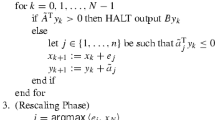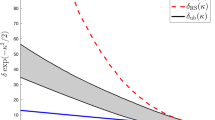Abstract
The perceptron and the von Neumann algorithms were developed to solve linear feasibility problems. In this paper, we investigate and reveal the duality relationship between these two algorithms. The specific forms of linear feasibility problems solved by the perceptron and the von Neumann algorithms are a pair of alternative systems by the Farkas Lemma. A solution of one problem serves as an infeasibility certificate of its alternative system. Further, we adapt an Approximate Farkas Lemma to interpret the meaning of an approximate solution from its alternative perspective. The Approximate Farkas Lemma also enables us to derive bounds for the distance to feasibility or infeasibility from approximate solutions of the alternative systems. Based on these observations, we interpret variants of the perceptron algorithm as variants of the von Neumann algorithm and vice versa, as well as transit the complexity results from one family to the other.
Access this chapter
Tax calculation will be finalised at checkout
Purchases are for personal use only
Similar content being viewed by others
References
Bárány, I., Onn, S.: Colourful linear programming and its relatives. Mathe. Oper. Res. 22(3), 550–567 (1997)
Beck, A., Teboulle, M.: A conditional gradient method with linear rate of convergence for solving convex linear systems. Math. Methods Oper. Res. 59, 235–247 (2004)
Bertsimas, D., Tsitsiklis, J.N.: Introduction to Linear Optimization. Nashua, NH, (1997)
Blum, A., Dunagan, J.: Smoothed analysis of the perceptron algorithm for linear programming. In: Proceedings of the 13th Annual ACM-SIAM Symposium on Discrete Algorithms, publisher: SIAM, Philadalphia, PA, pp. 905–914 (2002)
Blum, A., Frieze, A., Kannan, R., Vempala, S.: A polynomial-time algorithm for learning noisy linear threshold functions. Algorithmica 22(1), (1998)
Cheung, D., Cucker, F.: A new condition number for linear programming. Math. Program. 91, 163–174 (2001)
Dantzig, G.B.: Converting a converging algorithm into a polynomially bounded algorithm. Technical Report SOL 91-5, Stanford University, (1991)
Dantzig, G.B.: Bracketing to speed convergence illustrated on the von Neumann algorithm for finding a feasible solution to a linear program with a convexity constraint. Technical Report SOL 92-6, Stanford University, (1992)
Dantzig, G.B.: An ε-precise feasible solution to a linear program with a convexity constraint in 1∕ε 2 iterations independent of problem size. Technical Report SOL 92-5, Stanford University, (1992)
Dunagan, J., Vempala, S.: A simple polynomial-time rescaling algorithm for solving linear programs. In: Proceedings of STOC’04, pp. 315–320. ACM Press, New York, NY, (2004)
Epelman, M.A., Freund, R.M.: Condition number complexity of an elementary algorithm for resolving a conic linear system. Operations Research Center, Massachusetts Institute of Technology. Working paper, 319–97 (1997)
Epelman, M.A., Freund, R.M.: Condition number complexity of an elementary algorithm for computing a reliable solution of a conic linear system. Math. Program. 88, 451–485 (2000)
Frank, M., Wolfe, P.: An algorithm for quadratic programming. Naval Res. Logist. Q. 3, 95–110 (1956)
Freund, R.M.: Dual gauge programs, with applications to quadratic programming and the minimum-norm problem. Math. Program. 38, 47–67 (1987)
Freund, R.M., Vera, J.R.: Some characterizations and properties of the “distance to ill-posedness” and the condition measure of a conic linear system. Math. Program. 86(2), 225–260 (1999)
Freund, R.M., Vera, J.R.: Equivalence of convex problem geometry and computational complexity in the separation oracle model. Math. Oper. Res. 34, 869–879 (2009)
Gonçalves, J.P.M.: A family of linear programming algorithms based on the von Neumann algorithm. PhD Thesis, Department of Industrial and Systems Engineering, Lehigh University, Bethlehem (2004)
Khachian, L.G.: A polynomial algorithm for linear programming. Sov. Math. Dokl. 20, 191–194 (1979)
Klafszky, E., Terlaky, T.: On the ellipsoid method. Rad. Math. 8, 269–280 (1992)
Li, D.: On rescaling algorithms for linear optimization, PhD Proposal, Revised. Department of Industrial and Systems Engineering, Lehigh University, Bethlehem, (2011)
Minsky, M., Papert, S.A.: Perceptrons: An Introduction To Computational Geometry. MIT Press, Cambridge, MA, (1969)
Renegar, J.: Linear programming, complexity theory and elementary functional analysis. Technical Report 1090, School of Operations Research and Industrial Engineering College of Engineering, Cornell University, Ithaca, NY, USA, (1994)
Renegar, J.: Some perturbation theory for linear programming. Math. Program. 65, 73–91 (1994)
Roos, C., Terlaky, T., Vial, J.-P.: Interior Point Methods for Linear Optimization. Springer, New York, NY, (2006)
Rosenblatt, F.: The perceptron – a perceiving and recognizing automaton. Technical Report 85-460-1, Cornell Aeronautical Laboratory, Ithaca, NY, USA, (1957)
Schrijver, A.: Theory of Linear and Integer Programming. Wiley, Hoboken, NJ, (1998)
Shawe-Taylor, J., Cristianini, N.: Support Vector Machines and Other Kernel-Based Learning Methods. Cambridge University Press Cambridge, England, (2000)
Soheili, N., Peña, J.: A primal-dual smooth perceptron-von Neumann algorithm. In: Discrete Geometry and Optimization Fields Institute Communications 69, 303–320 (2013)
Soheili, N., Peña, J.: A smooth perceptron algorithm. SIAM J. Optim. 22(2), 728–737 (2012)
Todd, M.J., Ye, Y.: Approximate Farkas Lemmas and stopping rules for iterative infeasible-point algorithms for linear programming. Math. Program. 81, 1–21 (1998)
Author information
Authors and Affiliations
Corresponding author
Editor information
Editors and Affiliations
Rights and permissions
Copyright information
© 2013 Springer Science+Business Media New York
About this paper
Cite this paper
Li, D., Terlaky, T. (2013). The Duality Between the Perceptron Algorithm and the von Neumann Algorithm. In: Zuluaga, L., Terlaky, T. (eds) Modeling and Optimization: Theory and Applications. Springer Proceedings in Mathematics & Statistics, vol 62. Springer, New York, NY. https://doi.org/10.1007/978-1-4614-8987-0_5
Download citation
DOI: https://doi.org/10.1007/978-1-4614-8987-0_5
Published:
Publisher Name: Springer, New York, NY
Print ISBN: 978-1-4614-8986-3
Online ISBN: 978-1-4614-8987-0
eBook Packages: Mathematics and StatisticsMathematics and Statistics (R0)




